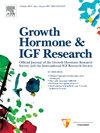Pharmacodynamics, pharmacokinetics, and toxicology of Fc-growth hormone fusion protein in macaques
IF 1.6
4区 医学
Q4 CELL BIOLOGY
引用次数: 0
Abstract
Purpose
Growth hormone (GH) therapy for GH deficiency is used to treat multiple conditions. However, the short half-life of GH necessitates frequent dosing, which limits patient adherence. Fc fusion proteins, created by binding an active peptide to the Fc portion of IgG, are known to prolong the plasma half-life of the peptide. Pharmacodynamics and pharmacokinetics of Fc-GH in rats have been reported; however, studies in primate models are lacking. Therefore, in this study, we aimed to investigate the pharmacodynamics, pharmacokinetics, and toxicology of Fc-GH in rhesus and crab-eating macaques.
Methods
In rhesus macaques, Fc-GH was injected subcutaneously at 0.8, 1.6, and 3.2 mg/kg and intravenously at 1.6 mg/kg. The 1.6 mg/kg subcutaneous dose was administered five times, once every 7 days; other doses were administered as single injections for pharmacodynamic and pharmacokinetic assessments. In crab-eating macaques, potential toxicity was evaluated after single subcutaneous injections at 30, 45, and 62.5 mg/kg and repeated injections at 3, 10, and 30 mg/kg once every 7 days, followed by an 8-week recovery.
Results
No adverse events were observed following Fc-GH administrations. Fc-GH achieved Cmax slowly after subcutaneous administration and rapidly after intravenous administration, with plasma levels being maintained over time. In rhesus macaques, the half-life increased dose-dependently: 23.72 ± 2.17 h (0.8 mg/kg), 49.44 ± 14.77 h (1.6 mg/kg), and 76.07 ± 13.19 h (3.2 mg/kg). After five injections of 1.6 mg/kg, the half-life of Fc-GH was 60.42 ± 18.29 h. Insulin-like growth factor 1 (IGF-1) and insulin-like growth factor binding protein 3 (IGFBP-3) levels significantly increased and remained elevated for 28–42 days after Fc-GH injections. In crab-eating macaques, no Fc-GH accumulation was observed. The maximum tolerated single subcutaneous dose was 62.5 mg/kg; no adverse effects were observed at 30 mg/kg during repeated administration over 29 injections with an 8-week recovery.
Conclusions
Fc-GH demonstrated favorable pharmacokinetics and pharmacodynamics in macaques, significantly extending the half-life and enhancing IGF-1 and IGFBP-3 levels without adverse effects. These findings suggest Fc-GH as a promising long-acting GH therapy that could improve patient adherence.
fc -生长激素融合蛋白在猕猴体内的药效学、药代动力学和毒理学研究
目的:生长激素(GH)治疗生长激素缺乏症可用于治疗多种疾病。然而,生长激素的半衰期短,需要频繁给药,这限制了患者的依从性。Fc融合蛋白是通过将活性肽与IgG的Fc部分结合而产生的,已知可以延长肽的血浆半衰期。Fc-GH在大鼠体内的药效学和药代动力学已有报道;然而,缺乏对灵长类动物模型的研究。因此,在本研究中,我们旨在研究Fc-GH在恒河猴和食蟹猕猴体内的药效学、药代动力学和毒理学。方法恒河猴分别以0.8、1.6、3.2 mg/kg皮下注射和1.6 mg/kg静脉注射Fc-GH。1.6 mg/kg皮下给药5次,每7天1次;其他剂量以单次注射方式进行药效学和药代动力学评估。对食蟹猕猴进行30、45和62.5 mg/kg单次皮下注射,并每7天重复注射一次3、10和30 mg/kg,随后8周恢复,评估潜在毒性。结果给药后无不良反应发生。Fc-GH在皮下给药后缓慢达到Cmax,在静脉给药后迅速达到Cmax,血浆水平随时间保持不变。恒河猴的半衰期分别为23.72±2.17 h (0.8 mg/kg)、49.44±14.77 h (1.6 mg/kg)和76.07±13.19 h (3.2 mg/kg)。注射5次1.6 mg/kg后,Fc-GH的半衰期为60.42±18.29 h,胰岛素样生长因子1 (IGF-1)和胰岛素样生长因子结合蛋白3 (IGFBP-3)水平显著升高,并在注射后28-42 d内保持升高。在食蟹猕猴中,未观察到Fc-GH积累。单次皮下最大耐受剂量为62.5 mg/kg;在30 mg/kg的剂量下重复给药29次,恢复时间为8周,未观察到不良反应。结论sfc - gh在猕猴体内具有良好的药代动力学和药效学特性,可显著延长半衰期,提高IGF-1和IGFBP-3水平,且无不良反应。这些发现表明Fc-GH是一种很有希望的长效生长激素疗法,可以提高患者的依从性。
本文章由计算机程序翻译,如有差异,请以英文原文为准。
求助全文
约1分钟内获得全文
求助全文
来源期刊

Growth Hormone & Igf Research
医学-内分泌学与代谢
CiteScore
3.30
自引率
0.00%
发文量
38
审稿时长
57 days
期刊介绍:
Growth Hormone & IGF Research is a forum for research on the regulation of growth and metabolism in humans, animals, tissues and cells. It publishes articles on all aspects of growth-promoting and growth-inhibiting hormones and factors, with particular emphasis on insulin-like growth factors (IGFs) and growth hormone. This reflects the increasing importance of growth hormone and IGFs in clinical medicine and in the treatment of diseases.
 求助内容:
求助内容: 应助结果提醒方式:
应助结果提醒方式:


